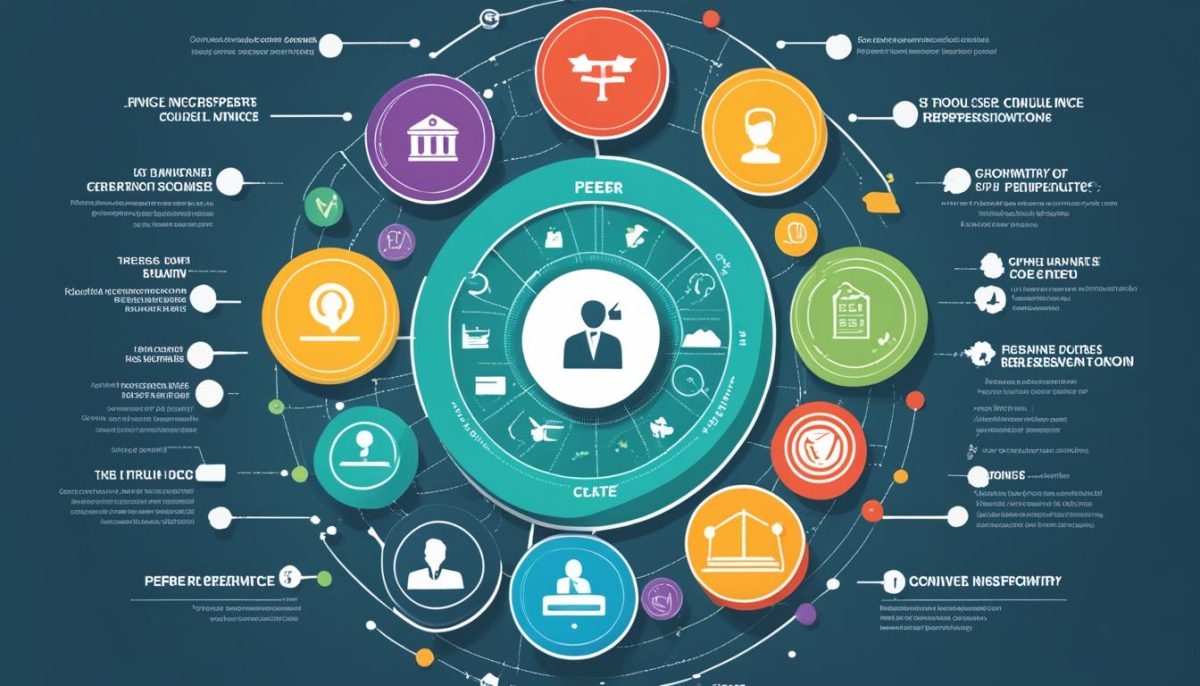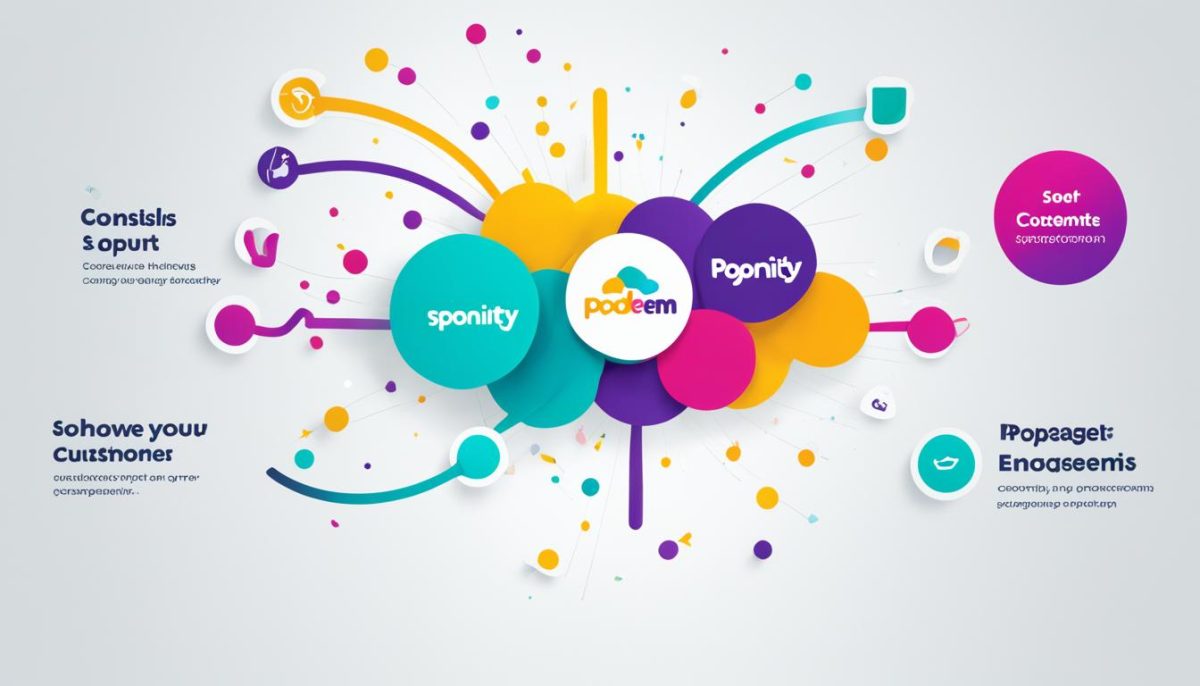Have you ever wondered how your social circles shape your behavior and decisions? Peer influence plays a profound role in our lives, guiding our thoughts, actions, and choices. In this section, we will explore the power and significance of peer influence, and how social circles impact our behavior and decision-making processes.
Through our insightful infograph, we will delve into the various ways in which peers can shape our lives. From the clothes we wear to the products we buy, peer influence affects our daily choices. By understanding the mechanisms behind peer influence, we can gain valuable insights into how social circles shape our behavior and decisions.
Join us as we uncover the compelling impact of peer influence on diverse areas, such as consumer behavior, career choices, and personal beliefs. We will analyze real-life examples and case studies that illustrate how peers sway our decisions.
Stay tuned for the next sections, where we will explore the role of social circles in shaping behavior, understand the mechanisms of peer influence through infographics, and discover strategies for nurturing positive peer influence for personal growth.
The Role of Social Circles in Shaping Behavior
When it comes to shaping our behavior, social circles play a pivotal role in influencing how we think and act. Our friends, family, colleagues, and the communities we belong to all contribute to the formation of our attitudes and choices. The power of social influence within these circles cannot be underestimated.
One of the key concepts associated with the influence of social circles is conformity. As humans, we have a natural tendency to conform to the norms and values of our social groups. Whether it’s adopting a particular fashion trend or aligning our beliefs with those of our peers, conformity often drives our behavior.
The influence exerted by social circles goes beyond mere conformity. It extends to shaping our beliefs, preferences, and decision-making processes. Our friends and acquaintances can inspire us to adopt certain behaviors or change our perspectives on various topics, from important life decisions to more day-to-day choices. This influence has a profound impact on our lives, sometimes without us even realizing it.
For example, imagine being part of a social circle where everyone prioritizes environmental sustainability. Over time, your own values and behaviors may align with this group, influencing your choices in areas such as consuming eco-friendly products, participating in environmental initiatives, and advocating for sustainable practices.
Understanding how social circles shape our behavior is crucial for comprehending the power of peer influence. It enables us to gain insights into the underlying mechanisms that drive our choices and actions. By recognizing the impact of our social environment, we can more consciously navigate the influence of our social circles and make informed decisions that align with our personal values and goals.
Uncovering the Compelling Influence of Peers on Decisions
When it comes to decision making, we often rely on the opinions and choices of our peers. Peer influence plays a significant role in shaping our own decision-making processes, leading to profound impacts on various aspects of our lives. Let’s explore how the decisions and choices made by our peers can greatly influence our own journeys.
Real-life examples and case studies provide us with invaluable insights into the power of peer influence. One such area where peer influence is evident is consumer behavior. Think about the last time you purchased a new gadget or tried out a trendy restaurant. Was it because your friends or colleagues recommended it? The influence of peer recommendations can be powerful, impacting our purchasing decisions and shaping our preferences.
Peer influence also extends to career choices. As we observe the career paths pursued by our peers, we may feel inspired to embark on similar paths or explore new industries based on their success and satisfaction. Hearing about the achievements and experiences of our peers can fuel our own aspirations and influence our decisions to pursue certain professions.
Furthermore, peer influence can shape our personal beliefs and attitudes. We often find ourselves adopting the values, opinions, and ideologies of our social circles. Whether it’s political views, religious beliefs, or lifestyle choices, our peers can significantly impact our own perspectives and choices.
To illustrate the impact of peer influence on decision making, let’s consider a case study:
A group of friends is planning a vacation, and there are multiple destination options on the table. Each member of the group has their own preferences and considerations. As they discuss the possibilities, one friend passionately advocates for a particular destination, sharing their personal experiences and recommendations. Gradually, the group begins to align their choices with this friend, influenced by their enthusiasm and persuasive arguments. Eventually, they unanimously decide to follow this friend’s lead and book the vacation to the suggested destination.
This example highlights how peer influence can sway decisions and lead to a collective choice influenced by a single individual. It demonstrates the significant impact that peers can have on the decision-making processes within a social group.
Peer Influence in Decision Making: Key Takeaways
- Peers can greatly influence our decision making in various spheres, including consumer behavior, career choices, and personal beliefs.
- Real-life examples and case studies offer valuable insights into how peer influence shapes our decisions.
- By recognizing the power of peer influence, we can better understand the factors impacting our own choices and actions.
Through exploring the compelling influence of peers on decisions, we gain a deeper understanding of how social interactions and relationships shape our lives. Peer influence can be both empowering and influential, guiding our decisions and impacting our journey of personal growth and development.
| Peer Influence Impact | Examples |
|---|---|
| Consumer Behavior | Friends recommending products or services that influence our purchasing decisions |
| Career Choices | Peers inspiring us to explore new industries or pursue certain professions |
| Personal Beliefs | Peers shaping our perspectives on politics, religion, and lifestyle choices |
Understanding the profound impact of peer influence on decisions allows us to navigate our social circles more consciously and make informed choices that align with our own values and aspirations. By harnessing the positive aspects of peer influence, we can leverage the power of collective decision making for personal growth and fulfillment.
Understanding the Mechanisms of Peer Influence through Infographics
In today’s digital age, where information is constantly bombarding us from various sources, visual representation plays a crucial role in conveying complex concepts effectively. When it comes to understanding the intricate mechanisms of peer influence, infographics provide a powerful tool for simplifying and capturing key insights.
Infographics combine the use of graphics, data visualization, and concise text to present information in a visually appealing and easily understandable format. By utilizing compelling visuals and clear design, infographics enable us to grasp the nuances of peer influence, uncovering valuable insights into how social circles shape our behavior and decisions.
Through infographics, we can visually represent the intricate web of peer influence, showcasing how our thoughts, actions, and choices are influenced by the people around us. The combination of text and graphics allows for better comprehension of the underlying dynamics and psychological processes involved in peer influence.

Visualizing Key Insights
Infographics provide a unique opportunity to transform complex data and theories into easily digestible visual representations. By capturing key insights in a visually engaging manner, infographics allow us to absorb and retain information more effectively.
When studying peer influence, infographics can highlight specific research findings, such as the impact of peer pressure on decision making, the influence of social norms on behavior, and the role of social comparison in shaping our attitudes and beliefs. With visual representation, these insights become more accessible and memorable, encouraging deeper understanding and analysis.
Creating Meaningful Connections
Infographics have the power to establish an emotional connection with the audience, evoking curiosity, interest, and empathy. By combining data and visuals, they can communicate complex ideas in a relatable and engaging manner.
When exploring the mechanisms of peer influence, infographics can depict real-life scenarios and relatable examples, making the subject matter more relatable and applicable. This enables individuals to see themselves in the context of peer influence, leading to personal insights and self-reflection.
Enhancing Learning and Retention
The human brain processes visual information faster and retains it for longer periods compared to textual information alone. By leveraging the power of visuals, infographics promote active learning and enhance information retention.
Infographics enable us to internalize and remember key concepts related to peer influence more effectively. By presenting information in a visually appealing and concise manner, infographics engage different parts of the brain, facilitating better understanding and retention of the subject matter.
Summary
Infographics serve as a valuable tool in unraveling the complexities of peer influence. Through visually captivating and data-driven representations, infographics enhance our understanding of social dynamics, revealing valuable insights into how our social circles shape our behavior and decision-making processes. By harnessing the power of infographics, we can navigate the intricacies of peer influence with clarity and awareness.
| Benefits of Infographics in Understanding Peer Influence |
|---|
| Facilitates comprehension of complex concepts |
| Engages the visual and analytical parts of the brain |
| Promotes active learning and information retention |
| Establishes an emotional connection with the audience |
| Allows for relatable examples and real-life scenarios |
Nurturing Positive Peer Influence for Personal Growth
In our quest for personal growth and development, positive peer influence plays a crucial role in shaping who we are and what we strive to become. Surrounding ourselves with supportive and empowering social circles enables us to harness the power of peer influence to enhance our lives.
When we cultivate positive peer relationships based on trust, respect, and shared values, we create an environment where personal growth thrives. Our peers can inspire us to push beyond our limits, challenge our beliefs, and pursue our dreams with unwavering determination. Their encouragement and support fuel our aspirations and help us overcome obstacles along the way.
Empowerment is a natural byproduct of positive peer influence. As we immerse ourselves in a network of like-minded individuals, we gain the confidence to embrace our unique strengths and talents. Through their unwavering belief in us, our peers empower us to step outside our comfort zones, take risks, and embrace new opportunities for growth.
Support from our peers is a cornerstone of personal development. During times of uncertainty or setback, our social circles provide the much-needed emotional support and guidance to help us navigate challenges. Their empathy, understanding, and shared experiences remind us that we are not alone on our journey of personal growth. Together, we can face adversities, learn from them, and emerge stronger than ever.



